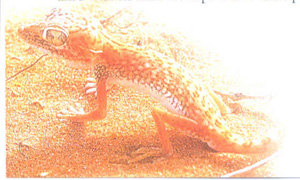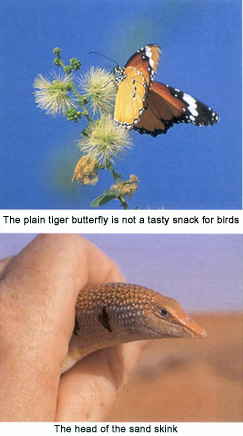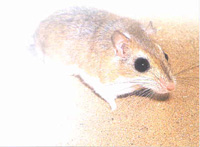|
Getting
away for a weekend into the countryside is
one of the great pleasures of life. The
change from the hectic life in the offices
and traffic of the big city to the silence
of the sands brings calm to the nerves and
a sense of wonder to the soul.
When you set out with the car, laden with
camping gear and cooling boxes full of
food and drinks, there is the sense of
adventure. It takes only half an hour to
leave the busyness of the city behind and
to see the dunes, rising ever higher on
either side of the road. A very good area
to find a nice camping spot is the dune
area southeast of Schwayb. A wide sandy wadi runs between the high dunes on the West and the dark rugged
mountains on the East. Before long, a
track shows the way to a secluded sandy
valley with a few picturesque ghaf
trees. The setting sun paints the dunes a
marvelous rose-red colour and the
mountains towards the East fade into blue
and purple, while the small sickle of the
moon rises slowly over their peaks.
Because the sliver of the moon does not
give off a lot of light, we can observe
the stars in all their glory. The
brightest at first is Venus. Soon we can
pick out the Plow and the hunter Orion,
while the twinkling Pleiades show up
later. Sometimes we spot a satellite on
its way around our globe, while at other
times an airplane with its blinking
wing-lights shows its presence before it
is heard.
The campfire warms us when the
temperatures fall, but even so, a warm
blanket around the shoulders is welcome.
The barbecue sizzles and from the valley
below we hear the bark of a fox, no doubt
attracted by the delicious smells of
roasting meat. Later the silent flight of
an owl momentarily blocks the flickering
stars.
 Even in the silent dunes, sleep on a thin
mattress is not always the best, so it is
not difficult to get up at sunrise. It is
worth the effort in any case.
Sunrise
over the dunes is always spectacular. Just
before the first rays shoot across the
mountain peaks, the dunes show themselves
in mysterious mists that blur the outline
of the ghaf trees. Dew lies heavy on the
tents and the spring flowers at the foot
of the dunes. The red colour of the sand
is accentuated by the bright green of the
saltbushes that grow at the foot of the
dunes.
Even in the silent dunes, sleep on a thin
mattress is not always the best, so it is
not difficult to get up at sunrise. It is
worth the effort in any case.
Sunrise
over the dunes is always spectacular. Just
before the first rays shoot across the
mountain peaks, the dunes show themselves
in mysterious mists that blur the outline
of the ghaf trees. Dew lies heavy on the
tents and the spring flowers at the foot
of the dunes. The red colour of the sand
is accentuated by the bright green of the
saltbushes that grow at the foot of the
dunes.
This is the best part of the trip: a walk
to "read the sands". The diffuse
light shows up every track in the sand and
outlines the sand patterns made by the
wind. The tracks in the sand tell us the
stories of what happened in the night.
Most of the life of the desert unfolds
when we sleep. The desert animals hide
from the heat and are active only at
night. With their large eyes they can
gather what little light there is, which
enables them to forage or hunt. Their huge
ears pick up the slightest sound and the
low temperature allows them to run after
prey or dig for food without losing too
much energy.
The fox that barked last night has come to
investigate if we left out any food. His
footprints are easy to recognize by the
sharp nails that are visible in front of
the pad. All around the camp, there are
the three-pronged prints left by gerbils,
of which there are many different kinds.
The two hind feet are kept close together
and look like one print, while the two
front feet are set a bit apart.
Near the tents, a small track leads to a
two-inch beetle that is standing in a
strange position with its abdomen pointing
upwards. If you look closely, you can see
why: dew has formed on its shields and by
standing with its head down, this water
trickles towards its head and mouth parts,
giving the beetle its much-needed
moisture.
Odd "bulldozer" tracks are left
by camel spiders or scorpions. Often they
come from or lead to a small slit
underneath a bush - the burrow where they
spend the daytime.
The camel spider has an undeserved bad
reputation. There are stories about how it
anesthesizes your skin and then eats away
at night without the victim feeling a
thing.
Although
it looks ferocious, it is really not
dangerous to people. Its Latin name (Solifuga)
means that it flees for the sun. It does
not like any kind of light (although it
seems attracted to camp fires sometimes)
and when it is disturbed and exposed to
light, it will run to the nearest shade,
which is usually the person that disturbed
him or that is holding the flash light.
And it runs fast, so its rush to safety is
misinterpreted as an attack.
Scorpions can be found at night if you use
a "black" (ultraviolet) light.
In this light they show up as small
greenish ghosts. It is surprising how many
of them are around, and yet few people
that camp are ever bothered by them. There
are some poisonous species and it is
better to avoid contact, for even if they
won't kill, they can cause some discomfort
and pain.
Going uphill is a strange track of slanted
stripes. One end of the stripe has a small
U-shape. This is the track left by a
side-winding snake. Here in the dunes that
would be either the sand viper or the
sawscale viper. The odd side-winding track
is made when the snake has to move through
loose sand. It pushes itself off by the
lower part of its body, while the front
third with its head are kept raised. The
open end of the "U" is the
direction in which it has been moving. It
is better not to find it, because the
vipers are poisonous, although not very
aggressive generally.
The track of a sand boa is a perfect sinus
graphic. Sand boas are small fat snakes
that live most of their life below the
surface of the sand. They are constricting
snakes, killing their prey (usually of
small rodents) by squeezing them to death.
Early morning is the best time to see
another of the subterranean sand dwellers:
the sand skinks or sand fish. They can
swim under the surface of the sand - quite
like a fish swims in water. They come out
early in the morning to
"sunbathe". They always emerge
form the sand on the lee side of a dune -
where the sand is very soft. All reptiles
are slow to move when they are cold and
need the sun's warmth to raise their body
temperature enough to move at speed.
 While the skink is still warming up, it
stays in a spot where it can dive deeply
in a split second. If you climb up the
hard side of the dune and carefully peer
over the edge, you have a chance to
observe the skink in action. They skitter
around for a bit, diving into the sand
just below the surface form time to time,
to emerge again and look for another place
for nice tidbits - mostly of insects.
While the skink is still warming up, it
stays in a spot where it can dive deeply
in a split second. If you climb up the
hard side of the dune and carefully peer
over the edge, you have a chance to
observe the skink in action. They skitter
around for a bit, diving into the sand
just below the surface form time to time,
to emerge again and look for another place
for nice tidbits - mostly of insects.
Their body is beautifully streamlined -
even their head has a counter-sunk lower
jaw - a shape that facilitates its
underground movements. Their ear holes can
be closed, while they also have special
scales that can cover their eyes for
protection. Their toes have fringes, which
helps in swimming through the sand. The
scales of their body are as smooth and
glossy as porcelain, and at least one of
the two species that we have here is very
colourful with black sidebars on its
overall orange-yellow body. Local bedouin
used to eat the sand skinks as a
much-needed addition of meat to their
meager diet of dates and camel or goat
milk.
At the bottom of the valley, where there
is more vegetation, the larger prints of
the desert hare are showing how they went
from place to place. Its prints are a bit
blurry, because the soles of its feet are
covered with hair that enable it to move
on soft, sometimes very hot sand. Although
the hare grazes at night, it has to be
able to run in the daytime, when it is
flushed from its resting place in the
shade of bushes. Unlike rabbits, hares do
not use burrows. They even drop their
young just somewhere on the sand and visit
them for the first few weeks several time
a day to feed them but leaving them most
of the time to fend for themselves.
"Early
morning is the best time to see another of
the subterranean sand dwellers: the sand
skinks or sand fish. They can swim
under the surface of the sand".
Some of the bushes are backlit by the low
rays of the sun and show a beautiful crop
of glossy pink "flowers". These
"flowers" are actually fruit
wings, paper-thin petals that surround the
seed and enable it to be carried by the
wind to far-off places to germinate.
One of the most conspicuous flowers of the
dunes is the white Campion - a plant that
opens its flowers at dusk and stays open
all night, for night-flying moths to
enjoy. Within a few hours after sunrise,
the dainty flowers close and the plant
looks uninteresting.
In one low-lying area there is a carpet of
small white four-petaled flowers. The
Latin name of this plant is Eremobium
eagyptiaca - which means "desert
life". After good rains they can
change the sands into a garden.
Further down a bright sulphur-yellow
flowering bush seems attractive, but when
you touch it, it turns out to have an
appalling smell. Somehow it is attractive
to the caterpillars of a butterfly - the
Plain Tiger. This butterfly has a
conspicuous colour pattern of orange black
and white, which tells birds that it is
not very tasty. The butterfly gets this
bad taste because its caterpillar always
feeds on plants that have bad-tasting or
poisonous juices.
The dry bed of the wadi is dotted with the
grey-green shrubs of the
Sodom
's
apple. This large bush indicates that
there has been too much grazing in this
area. Since the
Sodom
's
apple (Calotropis procera) is another one
of the bad-tasting plants, that are the
food plants of the Plain Tiger
caterpillar, it is not eaten by grazing
livestock. In areas where all other
vegetation disappears because of
overgrazing, the
Sodom
's
apple takes over and dominates the
landscape. It has rather attractive purple
flowers that hang in heavy bouquets
between the large round leaves. These
leaves feel woolly, due to a covering of
short white hairs. These hairs retain
moisture close to the surface of the leaf,
and reflect sunlight away from the leaf,
contributing in this way to the successful
survival of the plant. The woody roots of
the bush were used in the past to make
charcoal, which in turn was used to make
gunpowder. The fruit is shaped like a fat
banana and contains hundreds of seeds,
each with their own little parachute of
silken hairs that enable them to float far
on the wind. In
Northern
Africa
where this plant is ubiquitous, the fruits
are more round, looking like an apple,
which gave the plant its name.
In bygone years these dunes were also the
home of the cute white sand fox and the
very small sand cat. The cat has
disappeared, retreating into the less
disturbed dunes of the
Empty
Quarter
,
and the sand fox has become very rare. In
fact, it was thought to have gone also,
but has been sighted recently within the
area of Al Maha resort. Both small mammals
spend the day in burrows underground and
hunt at night, but they can be seen at
times in the early morning near their
burrows, warming themselves in the rays of
the rising sun.
Even though these days the wild flora and
fauna is diminished, it is still
worthwhile to spend some time enjoying the
peace of the desert and appreciating the
many ways in which wild plants and animals
manage to survive in an environment that
is very difficult and hostile during much
of the year. With more respect for this
desert life, it should be possible to
remember to take rubbish home and not to
drive off-track.

|
